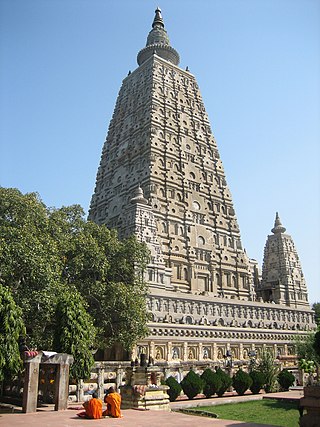
The Mahabodhi Temple or the Mahābodhi Mahāvihāra, a UNESCO World Heritage Site, is an ancient, but rebuilt and restored Buddhist temple in Bodh Gaya, Bihar, India, marking the location where the Buddha is said to have attained enlightenment. Bodh Gaya is 15 km from Gaya and is about 96 km (60 mi) from Patna. The site contains a descendant of the Bodhi Tree under which the Buddha gained enlightenment, and has been a major pilgrimage destination of Buddhists for over two thousand years.

The Bodhi Tree, also called the Mahabodhi Tree, Bo Tree, is a large sacred fig tree located in Bodh Gaya, Bihar, India. Siddhartha Gautama, the spiritual teacher who became known as the Buddha, is said to have attained enlightenment or buddhahood circa 500 BCE under this tree. In religious iconography, the Bodhi Tree is recognizable by its heart-shaped leaves, which are usually prominently displayed.
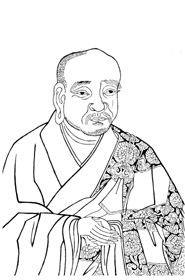
Aśvaghoṣa, also transliterated Ashvaghosha, was a Buddhist philosopher, dramatist, poet, musician, and orator from India. He was born in Saketa, today known as Ayodhya.

Saṅghamittā was an Indian Buddhist nun and believed to be the eldest daughter of Emperor Ashoka and his first wife and Empress, Devi. Together with her brother Mahinda, she entered an order of Buddhist monks. The two siblings later went to Sri Lanka to spread the teachings of Buddha at the request of King Devanampiya Tissa who was a contemporary of Ashoka. Ashoka was initially reluctant to send his daughter on an overseas mission. However, because of the insistence of Sangamitra herself, he finally agreed. She was sent to Sri Lanka together with several other nuns to start the nun-lineage of Bhikkhunis at the request of King Tissa to ordain queen Anulā and other women of Tissa's court at Anuradhapura who desired to be ordained as nuns after Mahindra converted them to Buddhism.

Jaya Sri Maha Bodhi is a historical sacred bo tree in the Mahamewuna Garden in historical city of Anuradhapura, Sri Lanka. This is believed to be a tree grown from a cutting of the southern branch from the historical sacred bo tree, Sri Maha Bodhi, which was destroyed during the time of Emperor Ashoka the Great, at Buddha Gaya in India, under which Siddhartha Gautama (Buddha) attained Enlightenment. The Buddhist nun Sangamitta Maha Theri, a daughter of Indian Emperor Ashoka, in 236 BC, brought the tree cutting to Sri Lanka during the reign of Sinhalese King Devanampiya Tissa.[1] At more than 2,300 years old, it is the oldest living human-planted tree in the world with a known planting date. The Mahavamsa, or the great chronicle of the Sinhalese, provides an elaborate account of the establishment of the Jaya Siri Maha Bodhi on the Island and the subsequent development of the site as a major Buddhist pilgrimage site.
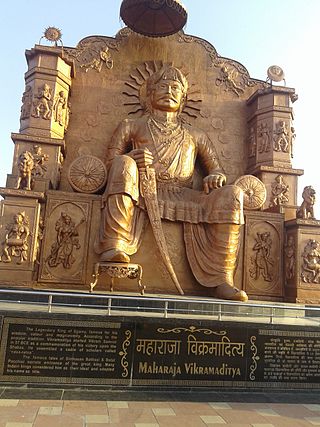
Vikramaditya was a legendary king mentioned in ancient Indian literature, featuring in traditional stories including those in Vetala Panchavimshati and Singhasan Battisi. Many describe him as ruler with his capital at Ujjain. "Vikramaditya" was also a common title adopted by several monarchs in ancient and medieval India, and the Vikramaditya legends may be embellished accounts of different kings. According to popular tradition, Vikramaditya began the Vikrama Samvat era in 57 BCE after defeating the Shakas, and those who believe that he is based on a historical figure place him around the first century BCE. However, this era is identified as "Vikrama Samvat" after the ninth century CE.

Matara is a major city in Sri Lanka, on the southern coast of Southern Province. It is the second largest city in Southern Province. It is 160 km (99 mi) from Colombo. It is a major commercial hub, and it is the administrative capital and largest city of Matara District.
Atamasthana or Eight sacred places are a series of locations in Sri Lanka where the Buddha had visited during his three visits to the country. The sacred places are known as Jaya Sri Maha Bodhiya, Ruwanwelisaya, Thuparamaya, Lovamahapaya, Abhayagiri Dagaba, Jetavanarama, Mirisaveti Stupa and Lankarama. They are situated in Anuradhapura, the capital of the ancient Anuradhapura Kingdom.

Uppalavanna was a Buddhist bhikkhuni, or nun, who was considered one of the top female disciples of the Buddha. She is considered the second of the Buddha's two chief female disciples, along with Khema. She was given the name Uppalavanna, meaning "color of a blue water lily", at birth due to the bluish color of her skin.

Sacred groves of India are forest fragments of varying sizes, which are communally protected, and which usually have a significant religious connotation for the protecting community. Hunting and logging are usually strictly prohibited within these patches. Other forms of forest usage like honey collection and deadwood collection are sometimes allowed on a sustainable basis. NGOs work with local villagers to protect such groves. Traditionally, and in some cases even today, members of the community take turns to protect the grove. The introduction of the protected area category community reserves under the Wild Life (Protection) Amendment Act, 2002 has introduced legislation for providing government protection to community held lands, which could include sacred groves.
Kalutara or Kalutota is a major city in Kalutara District, Western Province, Sri Lanka. It is also the administrative capital of Kalutara District. It is located approximately 43 km (27 mi) south of the capital Colombo. The city holds a unique position for one of the four major rivers in Sri Lanka, the Kalu Ganga, which joins the sea at the centre of the city. Kaluthara is known for making rope, baskets, and other articles from the fibre of the coconut palm. The area also produces the Mangosteens, a fruit introduced from Malaysia in the 19th century.
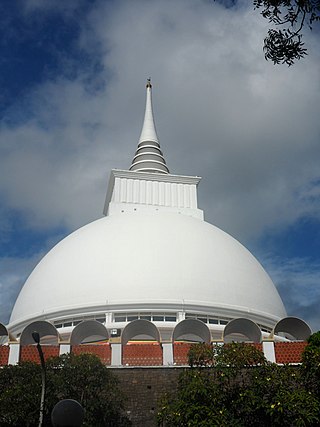
The Kalutara Chaitya is a Stupa located immediately south of the Kalutara Bridge in the Kalutara District of Sri Lanka.
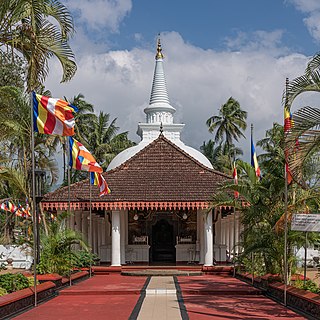
Muthiyangana Raja Maha Vihara is an ancient Buddhist temple located in the middle of Badulla town in the Badulla District of Uva Province in Sri Lanka.
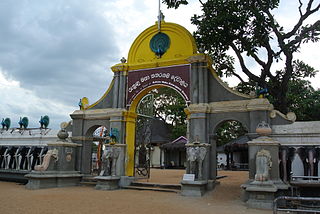
Kataragama is a pilgrimage town sacred to Hindu, Buddhist and indigenous Vedda people of Sri Lanka. People from South India also go there to worship. The town has the Kataragama temple, a shrine dedicated to Skanda Kumara also known as Kataragama deviyo. Kataragama is located in the Monaragala District of Uva province, Sri Lanka. It is 228 km (142 mi) southeast of Colombo. Although Kataragama was a small village in medieval times, today it is a fast-developing township surrounded by jungle in the southeastern region of Sri Lanka.

Maha Bodhi Ta Htaung is a Buddhist religious complex located in Monywa Township, Sagaing Region, Myanmar (Burma). It is known for the Giant Standing Buddha statue, the third tallest in the world, and for the Great Attitudes of U Narãda, who built the monastery. This Sāsana (religious) site contains thousands of Buddha statues beneath thousands of Bo trees, the Giant Reclining Buddha Statue, Aung Sekkya Stupa, and other large Buddha statues. Currently, a Sitting Buddha Statue, which is expected to become the world's largest Sitting Buddha Statue, is in construction. Many Buddhist monks can study the Buddhist Pariyatti literature at the monastery. Moreover, meditation centres or Vipassãnā centres are opened at this monastic site both for monks and laypersons.

Bellanwila Rajamaha Viharaya is a Buddhist temple situated in Bellanwila, Colombo District, Sri Lanka. Located around 12 km south to the Colombo city, near Dehiwala - Maharagama road, the temple attracts hundreds of devotees daily and is famous for its annual Esala Perehera festival which usually takes place in the month of August or September. One of the most venerated Buddhist temples in Sri Lanka, many devotees flock to worship the sacred Bo tree of Bellanwila Rajamaha Vihara, which is considered to be one of the first offshoots of Jaya Sri Maha Bodhi in Anuradhapura, Sri Lanka. The present chief incumbent of Bellanwila Rajamaha Vihara is Ven. Dr. Bellanwila Dhammaratana Nayaka Thera.
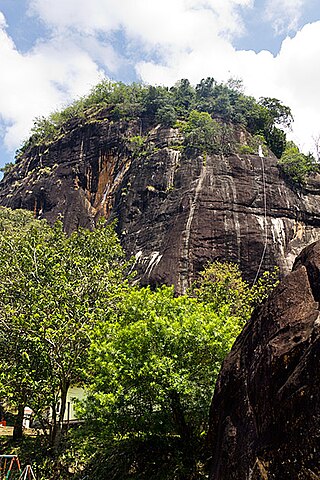
Mulkirigala Raja Maha Vihara is an ancient Buddhist temple in Mulkirigala, Sri Lanka. It has been built on a 205 m (673 ft) high natural rock, surrounded with another four rocks known as Benagala, Kondagala, Bisogala and Seelawathiegala. The temple site is located about 2 km (1.2 mi) from the Mulkirigala junction and can be reached from either Dikwella or Tangalle towns. The temple has been formally recognised by the Government as an archaeological site in Sri Lanka. The designation was declared on 8 April 1988 under the government Gazette number 501.

Kalutara Bodhiya is a Bodhi tree located in Kalutara, Western Province of Sri Lanka. Situated on the Galle Colombo main road, by the side of Kalu River just south to the Kalutara city, it is believed to be one of the 32 saplings of the Jaya Sri Maha Bodhi in Anuradhapura, Sri Lanka. A Buddhist temple Kalutara Viharaya and a modern Stupa, Kalutara Chaitya are located in close proximity to this sacred fig. One of the most venerated religious place in Sri Lanka, hundreds of Buddhists and foreign tourists visit this religious place daily.
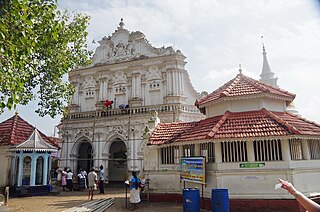
Kande Vihara is a major Buddhist temple in Kalutara District, Sri Lanka. The temple has got its name 'Kande vihara' as it is built on top of a hill located near to Aluthgama town. The temple has been formally recognised by the Government as an archaeological site in Sri Lanka.

Kataragama Bodhiya is a sacred fig located in Kataragama, Sri Lanka.



















